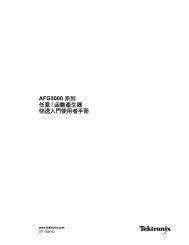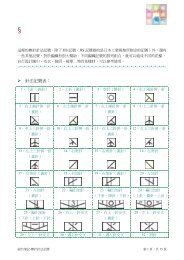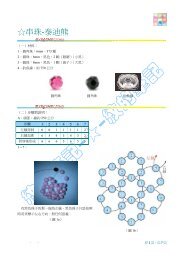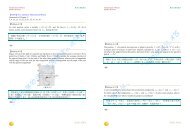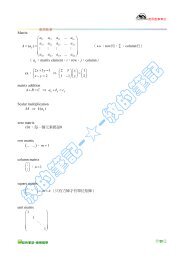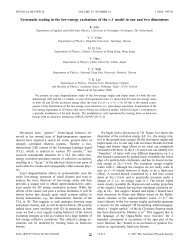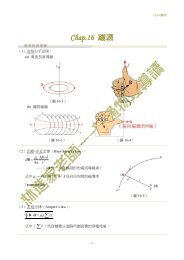Chapter 22 Materials Selection and Design Considerations
Chapter 22 Materials Selection and Design Considerations
Chapter 22 Materials Selection and Design Considerations
You also want an ePaper? Increase the reach of your titles
YUMPU automatically turns print PDFs into web optimized ePapers that Google loves.
(a) Derive stiffness <strong>and</strong> strength performance<br />
index expressions analogous to Equations<br />
<strong>22</strong>.9 <strong>and</strong> <strong>22</strong>.11 for this plate (Hint:<br />
solve for t in these two equations, <strong>and</strong> then<br />
substitute the resulting expressions into<br />
the mass equation, as expressed in terms<br />
of density <strong>and</strong> plate dimensions.)<br />
(b) From the properties database in Appendix<br />
B, select those metal alloys with<br />
stiffness performance indices greater than<br />
1.40 (for E <strong>and</strong> in units of GPa <strong>and</strong> g/cm 3 ,<br />
respectively).<br />
(c) Also using the cost database (Appendix<br />
C), conduct a cost analysis in the same manner<br />
as Section <strong>22</strong>.2. Relative to this analysis<br />
<strong>and</strong> that in part b, which alloy would you<br />
select on a stiffness-per-mass basis?<br />
(d) Now select those metal alloys having<br />
strength performance indices greater than<br />
5.0 (for <strong>and</strong> in units of MPa <strong>and</strong> g/cm 3 r<br />
sy r<br />
,<br />
respectively), <strong>and</strong> rank them from highest<br />
to lowest P.<br />
(e) And, using the cost database, rank the<br />
materials in part d from least to most<br />
costly. Relative to this analysis <strong>and</strong> that in<br />
part d, which alloy would you select on a<br />
strength-per-mass basis?<br />
(f) Which material would you select if<br />
both stiffness <strong>and</strong> strength are to be considered<br />
relative to this application? Justify<br />
your choice.<br />
<strong>Design</strong> <strong>and</strong> <strong>Materials</strong> <strong>Selection</strong> for Springs<br />
<strong>22</strong>.D7 A spring having a center-to-center diameter<br />
of 20 mm (0.8 in.) is to be constructed<br />
of cold-drawn <strong>and</strong> annealed 316 stainless<br />
steel wire that is 2.5 mm (0.10 in.) in diameter;<br />
this spring design calls for eight<br />
coils.<br />
(a) What is the maximum tensile load that<br />
may be applied such that the total spring<br />
deflection will be no more than 6.5 mm<br />
(0.26 in.)?<br />
(b) What is the maximum tensile load that<br />
may be applied without any permanent deformation<br />
of the spring wire? Assume that<br />
the shear yield strength is 0.6 sy, where sy is the yield strength in tension.<br />
<strong>Design</strong> Questions <strong>and</strong> Problems • W133<br />
<strong>22</strong>.D8 You have been asked to select a material for<br />
a spring that is to be stressed in tension. It<br />
is to consist of 10 coils, <strong>and</strong> the coil-to-coil<br />
diameter called for is 15 mm; furthermore,<br />
the diameter of the spring wire must be<br />
2.0 mm. Upon application of a tensile force<br />
of 35 N, the spring is to experience a deflection<br />
of no more than 12 mm, <strong>and</strong> not<br />
plastically deform.<br />
(a) From those materials included in the<br />
database in Appendix B, make a list of<br />
those c<strong>and</strong>idate materials that meet the<br />
above criteria.Assume that the shear yield<br />
strength is 0.6sy, where is the yield<br />
strength in tension, <strong>and</strong> that the shear<br />
modulus is equal to 0.4E, E being the modulus<br />
of elasticity.<br />
(b) Now, from this list of c<strong>and</strong>idate materials,<br />
select the one you would use for this<br />
spring application. In addition to the above<br />
criteria, the material must be relatively<br />
corrosion resistant, <strong>and</strong>, of course, capable<br />
of being fabricated into wire form. Justify<br />
your decision.<br />
<strong>22</strong>.D9 A spring having 7 coils <strong>and</strong> a coil-to-coil<br />
diameter of 0.5 in. is to be made of colddrawn<br />
steel wire. When a tensile load of<br />
15 lbf is applied the spring is to deflect no<br />
more than 0.60 in. The cold drawing operation<br />
will, of course, increase the shear<br />
yield strength of the wire, <strong>and</strong> it has been<br />
observed that ty (in ksi) depends on wire<br />
diameter d (in in.) according to<br />
t y � 63<br />
d 0.2<br />
(<strong>22</strong>.34)<br />
If the shear modulus for this steel is<br />
11.5 � 10 psi, calculate the minimum wire<br />
diameter required such that the spring will<br />
not plastically deform when subjected to<br />
the above load.<br />
<strong>22</strong>.D10 A helical spring is to be constructed from<br />
a 4340 steel. The design calls for 5 coils, a<br />
coil-to-coil diameter of 12 mm, <strong>and</strong> a wire<br />
diameter of 3 mm. Furthermore, a maximum<br />
total deflection of 5.0 mm is possible<br />
without any plastic deformation. Specify a<br />
heat treatment for this 4340 steel wire in<br />
order for the spring to meet the above criteria.<br />
Assume a shear modulus of 80 GPa<br />
6<br />
s y



